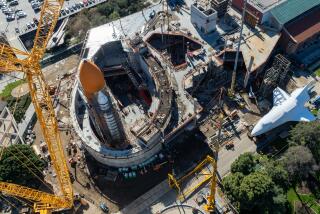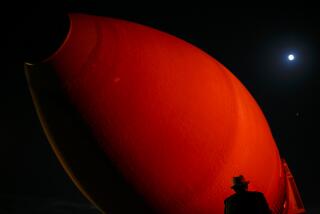Spacecraft to Test Technology for Flight to Mars
- Share via
HOUSTON — NASA is building an unlikely looking spacecraft at the Space Center, a half-melted appearing vehicle that will be launched from a shuttle in 1993 and fired into Earth’s atmosphere to test technology crucial for future flights to Mars.
The maneuver is one in which a spaceship arriving at a planet will plunge into the atmosphere at a carefully controlled angle, using atmospheric friction to slow down to orbital velocity.
At a precise point, flight control computers will alter the ship’s trajectory and the vehicle will soar back out of the atmosphere and into orbit.
Once safely in orbit, a lander attached to the vehicle can descend to the Martian surface or, if the ship has just returned from Mars or the moon, it can dock with a space station in Earth orbit.
The advantage to the maneuver, known as aerocapture, is that heavy rocket engines for braking and propellant to fire them would not have to be carried aboard the spaceship. The technique would prove useful at Mars and even more useful for the return to Earth where approach speeds would be much higher.
Increased Payload
The savings in weight--up to 50%, possibly--translates directly into increased payload and there appears to be little doubt that aerocapture of some sort will be used in any future manned Mars vehicles.
But major unknowns abound and the environment such vehicles will have to operate in is extreme in terms of aerodynamics and heating. A field of study called computational fluid dynamics provides many of the answers but a flight test is required to generate hard numbers.
Engineers at three NASA field centers are engaged in a $179-million project to build a 14-foot-wide aerocapture vehicle that will be launched from a space shuttle in mid-1993.
The overall goal of the project, managed at the Marshall Space Flight Center in Huntsville, Ala., is to improve computational models and techniques that will help scientists learn more about the heating effects and aerodynamics such vehicles will have to operate in, along with ways to improve their design.
Instrumented Heat Shield
The “aeroassist flight experiment”--AFE--was designed to achieve that goal with an instrumented heat shield that will allow scientists to compare theory with reality and thus better define the entry environment.
The test will simulate the return of a future space tug from geosynchronous orbit 22,000 miles above the Equator where communications satellites operate. But the principle is directly applicable to Mars vehicle technology.
The shuttle’s 50-foot robot arm will be used to deploy the AFE vehicle in its own orbit.
Equipped with up to 14 experiments, an on-board computer, communications gear and maneuvering rockets, the aeroassist vehicle will be fired into Earth’s atmosphere by an on-board solid-fuel rocket.
During the 10-minute flight, the vehicle will descend from the shuttle’s orbit to around 250,000 feet before soaring back out of the atmosphere like a rock skipping on water.
“It’ll actually enter over the Pacific Ocean and it will be at night,” said Donald Curry, an engineer at the Johnson Space Center, which is responsible for building the heat shield system.
“The purpose of that is so we can see it. It should make quite a show. We’ve got guidance and control on board that will then put it in the proper orbit and then the shuttle will pick it up and bring it back.”
Covered by Tiles
The vehicle’s thick “aerobrake,” or heat shield, will be covered by tiles like those used on the space shuttle.
It was designed to provide just the right amount of aerodynamic lift to accomplish the maneuver. Its shape is that of a rounded, tilted cone with a blunt apex.
The carrier vehicle “will contain all of the avionics equipment, the guidance equipment, it contains the solid rocket motor, the batteries, the heart of the equipment required for some of the experiments,” Curry said.
Instruments in the 800-pound aerobrake payload will measure heating rates and pressure as the vehicle plunges into the atmosphere to help engineers determine the optimum design for aerobrakes that will be needed for future spaceships.
Other instruments will measure the motion of the test vehicle to allow scientists to determine flight aerodynamics. The data will be compared with the predictions of computational fluid dynamics to help improve modeling techniques.






